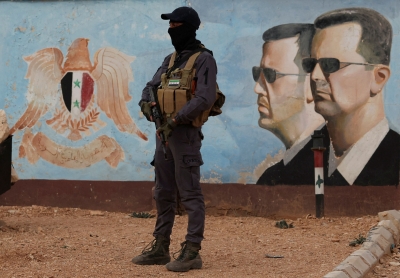Disinformation Campaigns Threaten Syria’s Fragile Post-Assad Order
The fall of Bashar al-Assad’s regime in Syria, after years of brutal civil war, has ushered in a new era fraught with uncertainty and instability. While the Sunni Islamist Hayat Tahrir al-Sham (HTS), formerly affiliated with al Qaeda, has claimed victory and pledged to protect minority rights, the country’s digital landscape is awash with disinformation campaigns that threaten to reignite sectarian tensions and derail the transition of power. Former allies and enemies of the ousted president, both domestic and foreign, are manipulating online narratives, utilizing sophisticated tactics to sow discord and undermine the nascent new order.
Analysts pinpoint disinformation as a key driver of social unrest and a significant obstacle to achieving stability. Bassam Alahmad, CEO of Syrians for Truth and Justice, emphasizes the destructive power of false narratives, equating their impact to that of physical weapons. The spread of manipulated videos, fabricated news reports, and inflammatory rhetoric aims to exploit existing societal fault lines and incite violence between different religious and ethnic groups. While HTS has severed ties with al Qaeda and vowed to protect minorities, the legacy of sectarian conflict and the influx of disinformation create a highly combustible environment.
Foreign actors, including Russia, China, Iran, and Israel, are implicated in these online campaigns, each pursuing its own geopolitical agenda in the aftermath of Assad’s removal. While these countries have not officially commented on their alleged involvement, researchers and analysts have documented evidence pointing to their activities. Pro-Assad forces, backed by Iran and Russia, are accused of utilizing online platforms to destabilize the new regime and potentially pave the way for a return to power or at least maintain influence. Meanwhile, China is accused of exploiting the situation to disseminate anti-U.S. narratives and bolster anti-Israel sentiment. Israel, on the other hand, is accused of using disinformation to justify its actions in the Golan Heights and solidify its control over the Druze population.
The mechanics of these disinformation campaigns involve a complex network of coordinated digital influence operations. Fake profiles, automated bots, and even AI-generated personas are deployed across social media platforms to amplify deceptive narratives and manipulate public opinion. One prominent example is the widely circulated video depicting a fire at an Alawite shrine in Aleppo, which was falsely presented as recent evidence of attacks against the minority group, fueling unrest and protests in several cities. The video, later debunked as predating HTS’s takeover, nonetheless served its purpose in inflaming tensions.
WhatsApp, a popular messaging app in Syria, has also become a breeding ground for disinformation. Assad loyalists utilize the platform to disseminate unverified reports and create an impression of chaos and anarchy, further undermining the new leadership. The widespread use of encrypted messaging apps makes it difficult to track and counter the spread of false information, posing a significant challenge for fact-checkers and independent media outlets.
Beyond outright falsehoods, the weaponization of narratives presents a more insidious threat. By selectively highlighting and distorting real events, external actors can manipulate public perception, stoke fear, and mobilize communities against the emerging political consensus. The example of Israeli activity in the Golan Heights highlights this tactic, where footage of a fringe figure expressing support for Israeli protection was amplified to create a false narrative of widespread Druze support for Israeli intervention. This manipulation of events serves to justify Israeli actions and further destabilize the region.
The vulnerability to disinformation is exacerbated by the perceived bias of local Syrian media, which has long been subject to political interference and censorship. The lack of credible and independent news sources makes it easier for manipulated narratives to take hold. Rebuilding trust in local media and fostering a robust independent media landscape are crucial steps in combating disinformation and fostering a more informed and resilient society. The need for capacity building and support for independent journalists is critical to establishing a media environment that prioritizes truth and accuracy over propaganda and political agendas. Ultimately, a well-informed populace is less susceptible to manipulation and better equipped to navigate the complex political landscape of post-Assad Syria.


